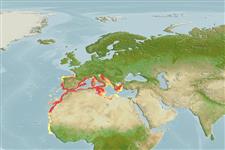Environment: milieu / climate zone / depth range / distribution range
Écologie
marin démersal; profondeur 60 - 596 m (Ref. 56504), usually 60 - 200 m (Ref. 26999). Subtropical; 35°N - 21°N
Eastern Atlantic: including the western Mediterranean.
Taille / Poids / Âge
Maturity: Lm ? range ? - ? cm
Max length : 20.0 cm TL mâle / non sexé; (Ref. 3397); common length : 11.5 cm TL mâle / non sexé; (Ref. 3397)
Épines dorsales (Total): 8; Rayons mous dorsaux (Total): 15; Rayons mous anaux: 15. Diagnosis: D1 VIII; D2 15; A 15; P 3 free + 6; V I + 5. Branchiostegal rays 6. Gill rakers 8. SLL (Ref. 55409).
Inhabits sandy and muddy bottoms (Ref. 3699). Depth range from 60-250 m (Ref. 04697) and from 288-596 m in the eastern Ionian Sea (Ref. 56504). Feeds on crustaceans, mainly amphipods (Ref. 4697).
Life cycle and mating behavior
Maturité | Reproduction | Frai | Œufs | Fécondité | Larves
Richards, W.J. and V.P. Saksena, 1990. Triglidae. p. 680-684. In J.C. Quero, J.C. Hureau, C. Karrer, A. Post and L. Saldanha (eds.) Check-list of the fishes of the eastern tropical Atlantic (CLOFETA). JNICT, Lisbon; SEI, Paris; and UNESCO, Paris. Vol. 2. (Ref. 3687)
Statut dans la liste rouge de l'IUCN (Ref. 130435)
Menace pour l'homme
Harmless
Utilisations par l'homme
Pêcheries: commercial
Plus d'informations
RéférencesAquacultureProfil d'aquacultureSouchesGénétiqueElectrophoresesHéritabilitéPathologiesTraitementNutrientsMass conversion
CollaborateursImagesStamps, Coins Misc.SonsCiguateraVitesseType de nageSurface branchialeOtolithesCerveauxVision
Outils
Articles particuliers
Télécharger en XML
Sources Internet
Estimates based on models
Preferred temperature (Ref.
123201): 13.3 - 17.3, mean 14.6 °C (based on 118 cells).
Phylogenetic diversity index (Ref.
82804): PD
50 = 0.5000 [Uniqueness, from 0.5 = low to 2.0 = high].
Bayesian length-weight: a=0.00933 (0.00769 - 0.01132), b=3.06 (3.00 - 3.12), in cm total length, based on LWR estimates for this species (Ref.
93245).
Niveau trophique (Ref.
69278): 3.7 ±0.52 se; based on food items.
Résilience (Ref.
120179): Milieu, temps minimum de doublement de population : 1,4 à 4,4 années (Preliminary K or Fecundity.).
Fishing Vulnerability (Ref.
59153): Low vulnerability (10 of 100).
Nutrients (Ref.
124155): Calcium = 121 [59, 313] mg/100g; Iron = 1.31 [0.68, 2.56] mg/100g; Protein = 18 [16, 20] %; Omega3 = 0.726 [0.324, 2.001] g/100g; Selenium = 34.6 [16.1, 81.2] μg/100g; VitaminA = 18.8 [6.6, 53.8] μg/100g; Zinc = 0.851 [0.582, 1.283] mg/100g (wet weight);
